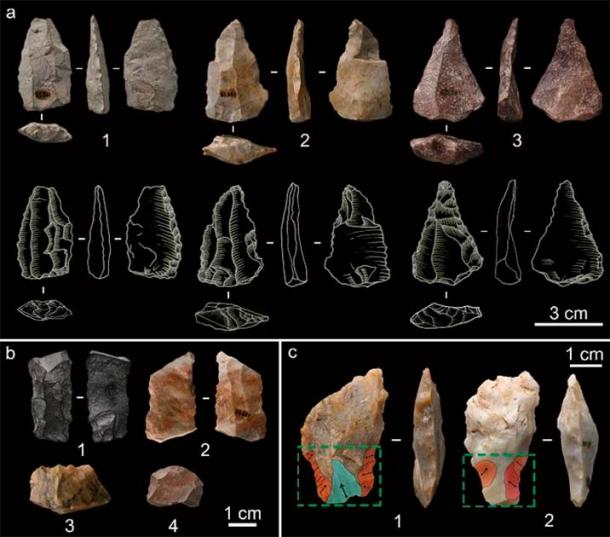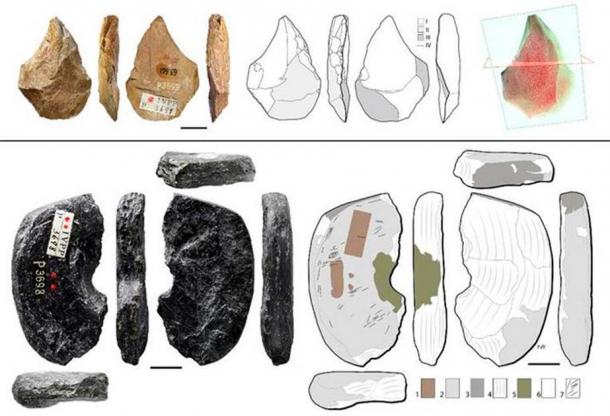New Evidence Shows Modern Humans First Arrived in China 45,000 Years Ago
A new study presents evidence showing that Homo sapiens (modern humans) arrived in China approximately 45,000 years ago, or several thousand years earlier than previously suspected. The original human settlers to the region likely arrived from the north and east, experts believe, migrating to northern China from the adjacent lands of modern-day Siberia and Mongolia.
An international team of researchers who study human evolution, led by Paleolithic archaeologist Shi-Xia Yang from the Chinese Academy of Sciences, completed a thorough re-examination of artifacts collected from a long-neglected and nearly forgotten archaeological site known as Shiyu, which is located in China’s Shanxi province. This fresh study just published in the journal Nature Ecology & Evolution uncovered the true age of this prehistoric human settlement, which will now be recognized as the oldest Homo sapiens site ever found on Chinese soil.
"Our new study identified an Initial Upper Paleolithic (IUP) archaeological assemblage from the Shiyu site of North China dating to 45,000 years ago that includes blade technology, tanged and hafted projectile points, long-distance obsidian transfer, and the use of a perforated graphite disk," Shi-Xia Yaong stated in a Chinese Academy of Sciences press release covering his teams findings.
- Study of Ancient Teeth Shows Single Native American Migration from Asia
- Study Finds Huge Undetected Migration Wave to Prehistoric Britain
In the context of the region as a whole, this discovery sheds new light on the migration of peoples from one territory to another over the course of several thousand years.
“The geographic expansion of Homo sapiens populations into southeastern Europe occurred by 47,000 years ago, marked by Initial Upper Paleolithic (IUP) technology,” the study authors explained in their Nature Ecology & Evolution paper:
“Homo sapiens was present in western Siberia by 45,000 years ago, and IUP industries indicate early entries by 50,000 years ago in the Russian Altai and 46–45,000 years ago in northern Mongolia. Homo sapiens was in northeastern Asia by 40,000 years ago, with a single IUP site in China dating to 43–41,000 years ago.”
Assumptions about when the migrations that started in southeastern Europe reached China were shaped primarily by the last discovery referenced above. But it seems that Shiyu could predate this other Chinese site by as much as 4,000 years, which represents a significant divergence from the previously accepted timeline.
- Breakthrough in Peopling of the Americas Finds a Female Lineage from China
- 40,000-year-old Tools Used by Ancient Humans Unearthed In North China
Revealing the Secrets of Asia’s Prehistoric Past
Excavations at Shiyu in 1963 produced more than 15,000 tools, weapons and personal items made from stone, along with thousands of animal bones that showed signs of having been touched or altered by human hands. While there was no doubt the site had been heavily used by ancient humans, the Chinese archaeologists who excavated the site were only able to recover a single piece of one Homo sapiens skull, meaning burials of the dead likely occurred elsewhere nearby.

Shiyu Initial Upper Palaeolithic Artifacts. a) Levallois points (1–3); b) other tool types including denticulate on blade (1, 2), denticulate on flake (3), and end scraper (4); c) tanged tools showing the locations of notched retouching (red) and thinning of the tangs (light blue). (IVPP/Nature)
Incredibly, much of this valuable evidence of prehistoric human activity was lost decades ago. Artifacts sent to the Institute of Vertebrate Paleontology and Paleoanthropology in Beijing for further study were preserved, but excavated items that were transferred to local facilities eventually disappeared, never to be seen again. About 90 percent of the stone objects recovered at Shiyu were lost, and the lone piece of skull bone was somehow misplaced as well.
The problem was that Shiyu was discovered and excavated shortly before the onset of China’s Cultural Revolution, which created intense social and political turmoil that hindered scientific exploration and study. The preservation of the past was not a priority during those times, as reformers were far more interested in building a future utopia than trying to protect an ancient cultural legacy.
The discoverers of the site knew that what they’d found was important. But the chaos and fear associated with the Cultural Revolution prevented a more exhaustive follow-up study from taking place, and that, combined with the loss of most of the artifacts that had been found, left a great deal of uncertainty about when Shiyu had been occupied and by whom.
It was only recently that a more extensive analysis of this ancient prehistorical site was finally launched, by researchers from China, France, Australia and Germany who were anxious to unlock Shiyu’s secrets and reveal more about the earliest inhabitants of the region.
If the skull piece had been preserved, modern techniques of DNA testing could have revealed its true age. But since that artifact was lost long ago, the researchers had to resort to other means to find out more about Shiyu’s ancient occupants.
Fortunately, other means were available. The researchers analyzed 15 sediment samples taken from the site using a technology known as optically stimulated luminescence (OSL), which can calculate how long grains of earth and rock found in an excavated sediment layer had been covered up and protected from sunlight. They also used carbon dating techniques to estimate the age of some of the animal bones and teeth found at the site, which were left there by the humans that had hunted and consumed the animals.
Correlating the data from these tests, the scientists determined that Shiyu would have been occupied by humans approximately 44,600 years ago. This was surprising, since up to now no evidence had emerged suggesting that Homo sapiens had arrived in China so early.
The excavation layer that produced signs of human occupation was found relatively close to the bottom of a 100-foot (30-meter) deposit of sand and soil that was dug up at the site. There was no evidence of further occupation in levels of sediment found closer to the surface, suggesting the site had been heavily used for a period of time before being abandoned tens of thousands of years ago.

Graphite disc and bone tool that was recovered from the Shiyu site. (IVPP/Nature)
A Complex Ancient Culture Rooted in Tradition and Innovation
The results of the analysis of animal fossils combined with use-wear analysis of stone tools showed that the prehistoric inhabitants of ancient Shiyu were horse hunters who preyed on adult horses for meat and hides. They had access to an advanced set of tools for processing the horses they harvested from local herds, including end-scrapers and awls unique to the Late Paleolithic plus highly efficient butchering tools from the Levallois industry that was first developed in the Middle Paleolithic. The occupants of Shiyu also manufactured tools from bone and graphite, and some of their stone tools were made from obsidian that would have been secured from sources located hundreds of miles away.
All in all, the variety and functionality of their tool industry makes it clear that the prehistoric residents of Shiya built a complex and sustainable culture that efficiently exploited the resources available in their region. This culture would have used a mixture of technologies and practices imported from the peoples’ original homelands in Siberia or Mongolia, physical objects acquired through trading activity, and new inventions and techniques that were unique to that time and place.
“Shiyu reflects a process of cultural creolization,” the Chinese Academy of Sciences press release states, “through contact between societies and relocated peoples, whereby inherited traits blended with novel innovations, thus complicating the traditional understanding of Homo sapiens' global expansion.
Top image: Reconstruction of Shiyu "horse-hunters", earliest known modern humans in China. Source: GUO Xiaocong/Nature
By Nathan Falde

















